Synthetic damage effect assessment through evidential reasoning approach and neural fuzzy inference: Application in ship target
Tinle YAO, Run MIAO,*, Weili WANG, Zhirong LI, Jun DONG,Yjun GU, Xuefei YAN
a Ordnance Engineering College, Naval University of Engineering, Wuhan 430000, China
b Xi’an Modern Chemistry Research Institute, Xi’an 710065, China
c Department of Equipment Command and Management, Army Engineering University, Shijiazhuang 050003, China
d Institute of Systems Engineering, Academy of Military Science, Beijing 100082, China
KEYWORDS
Abstract The damage effect assessment of anti-ship missiles combines system science and weapon science,which can provide reference for the assessment of battlefield damage situation. In order to solve the difficulty of heterogeneous data aggregation and the difficulty in constructing the mapping between factors and damage effect,this paper analyzes the specific damage process of the anti-ship missile to the ship, and proposes a synthetic Evidential Reasoning (ER) - Adaptive Neural Fuzzy Inference System(ANFIS)to assess the damage effect.To solve the problem of fuzziness and uncertainty of criteria in the assessment process, the belief structure model is used to transform qualitative and quantitative information into a unified mathematical structure, and ER algorithm is used to fuse the information of lower-level criteria.In order to solve the problem of fuzziness and uncertainty of the information contained in the first-level variables,and the strong non-linear characteristics of the mapping between first-level variables and damage effect, the ANFIS with selfadaptation and self-learning is constructed. The map between the three first-level variables and damage effect is established,and the interaction process of the various factors in the damage effect assessment are clear.Sensitivity analysis shows that assessment model has good stability.The result analysis and comparative analysis show that the process proposed in this paper can effectively assess the damage effect of anti-ship missiles, and all criteria data are objective and comparable.©2021 Chinese Society of Aeronautics and Astronautics.Production and hosting by Elsevier Ltd.This is an open access article under the CC BY-NC-ND license(http://creativecommons.org/licenses/by-nc-nd/4.0/).
1. Introduction
As the continuous development of anti-ship weapons,damage effect assessment of anti-ship missile becomes an important subject for long-term continuous research in various countries.In the actual combat process,the damage effect assessment involves damage source, damaged object, and damage process factors.It is the result of the interaction between damage source and damage object under specific conditions and has strong causality.This is a synthetic research involving weapon science and system science, and many factors need to be considered. The traditional damage effect assessment is based on the damage of the actual projectile to the ship, but it takes a long time and a huge investment in manpower,material and financial resources. Therefore, it is difficult to carry out actual projectile shooting tests on a large scale, and it is impossible to assess the damage effect under multi-factor conditions and the actual combat environment.Under such circumstances, an efficient and low-cost assessment process that can effectively assess the damage effect to ship target is urgently needed.
In the past 10 years, some works for analyzing the weapon system effect have been developed.Li et al.analyzed the characteristics and requirements of system target damage assessment, and used the exponent method to solve the quantitative relationship between the sub-target physical damage degree.Li et al.combined fuzzy theory and Bayesian network to establish a fuzzy Bayesian network model for target damage assessment, which can quickly assess the target damage effect under various attack conditions.Xiong et al.established a damage assessment model based on damage trees,and simulated the effects of different factors on the damage effect of ships.Mao et al.constructed a linear response system relationship model by characterizing the internal relationships of the combat system, and realized the analytical assessment of the operational effectiveness of the combat system. Aiming at achieving maximum protection coverage against enemy air threats, Rao and Ravishankarproposed a methodology for optimal deployment and effectiveness evaluation of air defence resources using game theory,which can assess the effectiveness of air defence in operations. In cyber operations area,Maathuisabc et al.proposed a decision support model for effects estimation and proportionality assessment for targeting in cyber operations to estimates and classifies the effects of cyber operations, and assesses proportionality to support targeting decisions in cyber operations. Based on the structure and working principle of the system, Chen et al.proposed a new evidential reasoning based approach with uncertain parameters evaluate the system performance, and analyzed the sensitivity of the evaluation result to propose the maintenance strategy on the subsystems that have a great impact on the performance of the whole system.
Although some works have been done on damage effect assessment, there are still three problems that have not been fully resolved in the actual assessment process, and further consideration is needed.
First, the damage effect assessment is different from the general capability assessment of a single weapon system. The damage effect assessment is to assess the result of an objective physical process,so it involves at least two interacting systems and the influence factors in the damage process. Therefore, in order to accurately and quantitatively assess the damage effect,when constructing the damage effect assessment criteria system,it is necessary to comprehensively analyze the criteria that affect the damage result or the interaction between systems during the damage process,so as to build a more synthetic criteria system.
Second, in the assessment process, it is necessary to fuse a lot of information with different structures, and these criteria data are often fuzzy and uncertain. The diverse forms of data not only make it difficult for data with different attributes to be compared and analyzed in a unified way, but also are not conducive to effective information fusion. The belief structure is a distribution using belief degrees to represent the performance of an alternative option on a criterion,which is a method of describing uncertainty.The belief structure can deal with the problem of knowledge representation when the information is incomplete and unknown, because it is suitable for simulating the subjective judgment when people only have a part of the facts of the research object.It has been successfully applied to quality function deploymentand multi-attribute decision-making and threat assessment,etc. Therefore,the belief structure provides a good solution to the inconsistency of the unknown data structure in the assessment process.As for information fusion, evidential reasoning approach provide a powerful tool. ER (Evidential Reasoning) approach is derived from Dempster-Shafer evidence theory which is first introduced by Dempsterand subsequently developed by G.Shafer.It is a flexible and useful mathematical tool for expressing and combining information,which has been widely used in the fields of information fusion. Yang and Singhfirst proposed the ER algorithm to fuse weighted evidence in multiattribute decision making. Based on ER algorithm, Yang and Xusubsequently proposed the ER rule.It has been proven that both Dempster’s rule and ER algorithm are the special case of the ER rule.For an assessment system with hierarchical structure, it is often aggregated from the bottom-level criteria to the top-level criteria,and a set of criteria with similar attributes can often constitute the same level.Therefore,the criteria at the top of the hierarchy are generally the most abstract.Damage effect assessment has typical hierarchical structure assessment criteria system. As special case of ER rule,ER algorithm contains the kernel content of ER rule.It has strong information fusion capability for hierarchical structure and is very easy to program. In the field of combat capability assessment, Jiang et al.has used ER algorithm to assess the capabilities of main battle tanks in different countries and achieved good results.Based on the above analysis,it is appropriate to consider using ER algorithm for information fusion in damage effect assessment.
The third is that the mapping between the criteria in hierarchical is non-linear, and the main factors that have strong causality has uncertainty in assessment process. Therefore,the reasonable mapping relationship needs to be established when fusing various information. For assessment problems with fuzzy and strong nonlinearity,the use of machine learning technology can effectively improve the accuracy of the assessment. Adaptive neural fuzzy inference system, developed by Jiang,is a multilayer adaptive network-based fuzzy inference that maps relations between inputs and outputs.It is useful for solving complex problems with large uncertainties by creating a fuzzy inference system with adjusted parameters of the membership function. According to the work of Kar et al.,fuzzy neural networks are able to approximate any plant with high degree of accuracy. It has many advantages of fuzzy logic and neural network, and can achieve self-learning and selfadaptation.This success has led to significantly conspicuous literature comprising of improvements and modifications,applications.Zhu et al.used ANFIS to solve similar problem in the economic field and achieved good results. Therefore, inspired by these works, ANFIS is used in this paper to accomplish effect assessment, which uses three rules and linear conclusions to construct the mapping between damage effect and the main factors. Through the trained network, the damage effect and the contribution rate η of each main factor to the damage effect can be obtained accurately.
Based on the analysis of the above problems and solutions,this paper proposes a synthetic assessment process based on ER approach and ANFIS to assess the damage effect:
Step 1. Establish the assessment criteria systems for main factors in damage process and construct reasonable criteria hierarchy respectively;
Step 2. Collect criteria data, mainly including simulation results and experts’ assessment information;
Step 3. Transform all types of data into belief structure to solve the problem of inconsistent data types;
Step 4. Use ER algorithm to aggregate all the lower-level criteria to main factors in damage process according to the hierarchical structure to obtain the assessment values of these factors;
Step 5.Construct a suitable ANFIS to map main factors to damage effect, and get the final assessment value of damage effect.
Step 6.Design tests to verify the assessment results and analyze the influencing factors of the damage process. If the deviation between the assessment results and the test results is too large, return to Step 2.
This paper is organized as follows. Section 2 analyzes the various assessment criteria in the damage process, and establishes the hierarchical structure of the assessment criteria system. Section 3 obtains the basic data of each criteria through simulation technology and experts’ assessment. Section 4 aggregates the data of the underlying criteria into the main factors of the damage process through the belief structure model and ER algorithm. Section 5 constructs an ANFIS to map main factors to damage effect, and gets the final assessment value of damage effect.Section 6 carried out a sensitivity analysis on the assessment results and compared them with the test results to verify the accuracy of the assessment results.Finally,conclusions and future works are offered in Section 7.
2. Construction of hierarchical structure of criteria system
The damage effect is the result of the interaction between the damage source and the damaged object.Moreover,the process is also related to actual combat conditions such as weather and detection.Therefore,the first-level variables that can influence the assessment results of damage effect can be expressed as warhead damage capability, damage resistance of ship, and guidance anti-jamming performance. In order to facilitate information fusion, C is used to represent each first-level variable, and the damage effect is represented as E.
In the actual assessment process, C, C, and Care comprehensive variables that cannot be directly measured. There are many influencing factors and a large number of lowerlevel criteria should be collected.Therefore,the assessment criteria system of C, C, and Cneed to be established respectively, and the reasonable hierarchical structure should be formed. The corresponding meaning of each variable and the hierarchical structure of damage effect assessment criteria system are shown in Fig. 1.
According to the characteristics of damage source and damage object, the hierarchical structure of warhead damage capability and damage resistance of ship are constructed first.a and c are respectively used to represent the lower-level criteria of warhead damage capability and damage resistance of ship. Warhead damage capability of the anti-ship missile mainly includes the warhead damage power and the warhead reliability.According to the actual process of anti-ship missiles damaging ships,the main manifestations of the warhead damage power include armor-piercing damage, shock wave damage and fragment damage, which are represented by a, a,and a. In order to decompose these three damage-related criteria into quantifiable criteria, based on simulation experiments, combined with relevant shooting tests in recent years,criteria a-asuch as shock wave overpressure and number of fragments are obtained. Seven experts from industrial sectors and research institutions are invited to assess the warhead reliability, and criteria a-asuch as guidance accuracy and fuze reliability are obtained. The damage resistance of ship is mainly determined by the ship structure and the ship material.Therefore, the damage resistance of ship structure should be composed of these two criteria, which are represented by cand c. At the same time, considering the types of structures and materials on the ship,the ship bulkhead structure and ship welding materials and other criteria cto ccan be obtained.
It can be seen from Fig. 1 that guidance anti-jamming performance mainly influence damage process because it can reflect the characteristics of the anti-ship missile guidance process. b is used to represent the lower-level criteria of guidance anti-jamming performance. Guidance anti-jamming performance mainly includes the performance of capturing targets and the performance of tracking targets,which are represented by band b.According to the relationship between the performance parameters of the anti-ship missile and the characteristics of the guidance process, band bare decomposed into quantifiable criteria bto bincluding capture time and guidance angle accuracy.
As is shown in Fig.2,after obtaining reasonable assessment values of C, C, and C, it is necessary to construct f to solve E. Suppose the mapping relationship between damage effect and first-level variables is
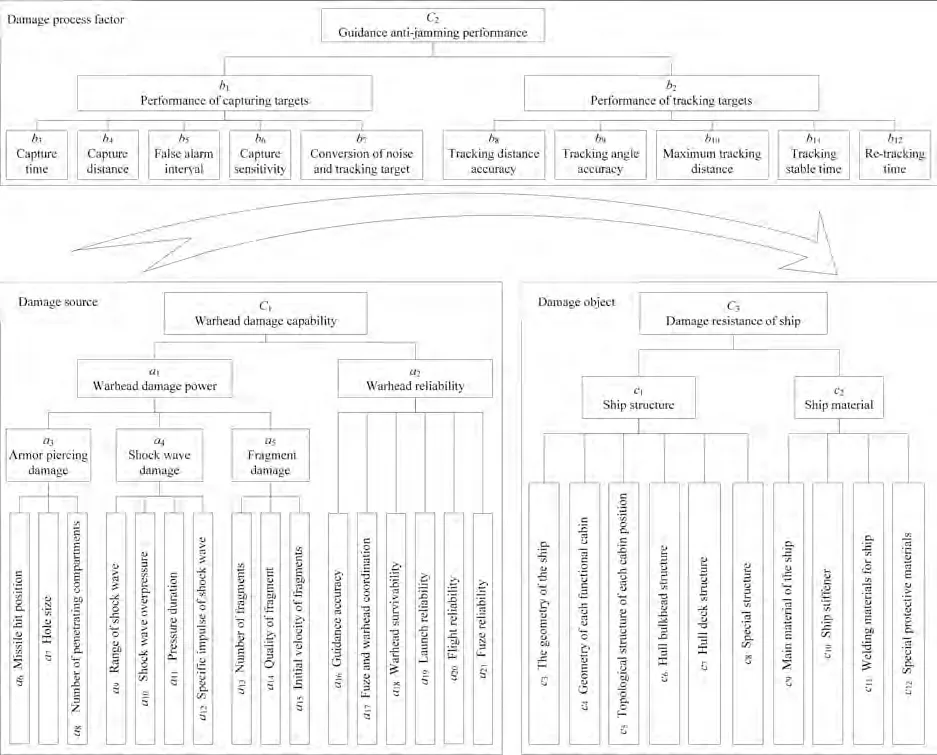
Fig. 1 Hierarchical structure of the assessment criteria system for damage effect of anti-ship missile.

Fig. 2 Hierarchical structure of damage effect assessment.

It can be seen from the Eq. (1) that the damage effect assessment first requires solving the three first-level variables C, C, and C, and then a suitable mapping f needs to be designed to accurately complete the mapping from C, C,Cto E. In assessment process, the relationship between E and C,C,Cis highly nonlinear,so f needs to have the capability to handle highly nonlinear relationship. At the same time, C, Cand Care comprehensive criteria aggregated from lower-level criteria. In the aggregation process, there are qualitative information and incomplete information fused into these three first-level variables, and the aggregation relationship is not a purely functional analytical equation. Moreover, C, Cand Care also criteria with fuzziness and incompleteness,so f should have the capability to process such information.
On this basis of forming the hierarchical structure in Figs.1 and 2, E will be solved.
3. Collection of criteria information
The information of the underlying criteria includes quantitative information and qualitative information.For quantitative information, it is very appropriate and necessary to obtain data by simulating the part of damage process on the ANSYS-LS-DYNA simulation platform. In accordance with the requirements of the assessment criteria system of C, C,and C, the basic quantitative data such as shock wave overpressure, fragment distribution, bulkhead flying, and quasistatic pressure are obtained by using the fluid-solid coupling algorithm to complete the finite element analysis.
The cabin is modeled on the combat command cabin of a certain type of frigate. The cabin is set as a cube with a size of 5 m × 4 m × 2.5 m, and the bulkhead thickness is 8 mm.The left and right bulkheads are only provided with longitudinal stiffeners, using No. 6 flat steel and ⊥4 × 150/6 × 80 T-s haped steel, with an interval of 0.5 m. The stiffeners of the top plate,bottom plate and front and rear bulkheads are made of No.8 flat steel and ⊥4×200/6×80 T-shaped steel,and the horizontal and vertical intersecting stiffeners are arranged.Among them, the T-shaped steel is only arranged longitudinally, with an interval of 1 m, and the flat steel balls are arranged horizontally and vertically, with an interval of 0.5 m. It simulates the perforated structure of the semiarmor piercing warhead penetrating the front bulkhead (sideboard direction). According to the warhead size, the hole diameter is ∅35 cm.
In the establishment of the finite element model,SOLID164 elements and eight-node hexahedral mapping mesh are used.The explosive is set as a cylindrical bare charge with a mass of 9 kg. The explosive is placed at the geometric center of the cabin,and a single point detonation is adopted.In the calculation, the Arbitrary Lagrange-Euler (ALE) algorithm is used for fluid-solid coupling. The air domain is set to be 40 cm larger than the outer size of the bulkhead,and the transmission boundary is set. In order to complete the description of the dynamic detonation shock wave pressure field, the*INITIAL_VOLUME_FRACTION_GEOMETRY detonation area setting is performed in the air domain,which can set the specified area in the Euler domain as an explosive unit and control the geometric shape keyword. At the same time, the keyword*INITIAL_DETONATION is set for the detonation point,which includes parameters such as the number and position of the detonation point, and set the speed value for the detonation area.The fixed connection failure model is adopted at the weld of the bulkhead, and the failure stress of the weld of the steel cabin is set to 400 MPa. The detailed simulation setting information of bulkhead, explosives and air area is shown in Table 1.
Based on the results of simulations, quantitative data are assessed by experts in this process. Fig. 3 and Fig. 4 are taken as examples to describe the performed finite element analysis model.
Fig. 3 shows the cloud diagram of the pressure field of the detonation product when the explosive is dynamically detonated.Fig.4 shows the influence of the number,size and speed of different fragments on the damage effect of the cabin.From the red circle mark in Fig.4,it can be seen that the stiffeners of the cabin are obviously deformed,and the holes caused by the dense fragments are also very obvious. The content of numerical simulation can accurately obtain qualitative and quantitative information of specific criteria in the assessment system.
For qualitative information, because the information is highly comprehensive and the cost is very high to decompose it to a measurable degree, the accuracy of qualitative data derived from the experience of experts is even higher in many cases. Seven experts from the industrial sectors and research institutions are invited in this paper to score the qualitative cri-teria shown in Table 2. The richness of the subjective experience of experts is usually reflected in the consistency of the scoring results, which has been elaborated by Yu and Lai.Therefore, the weights of the experts are assigned according to the consistency of the expert’s scoring result. Finally, the weights of the experts and the expert’s scoring results are aggregated in a linear manner, and the collection results of qualitative data shown in Table 1 can be obtained.
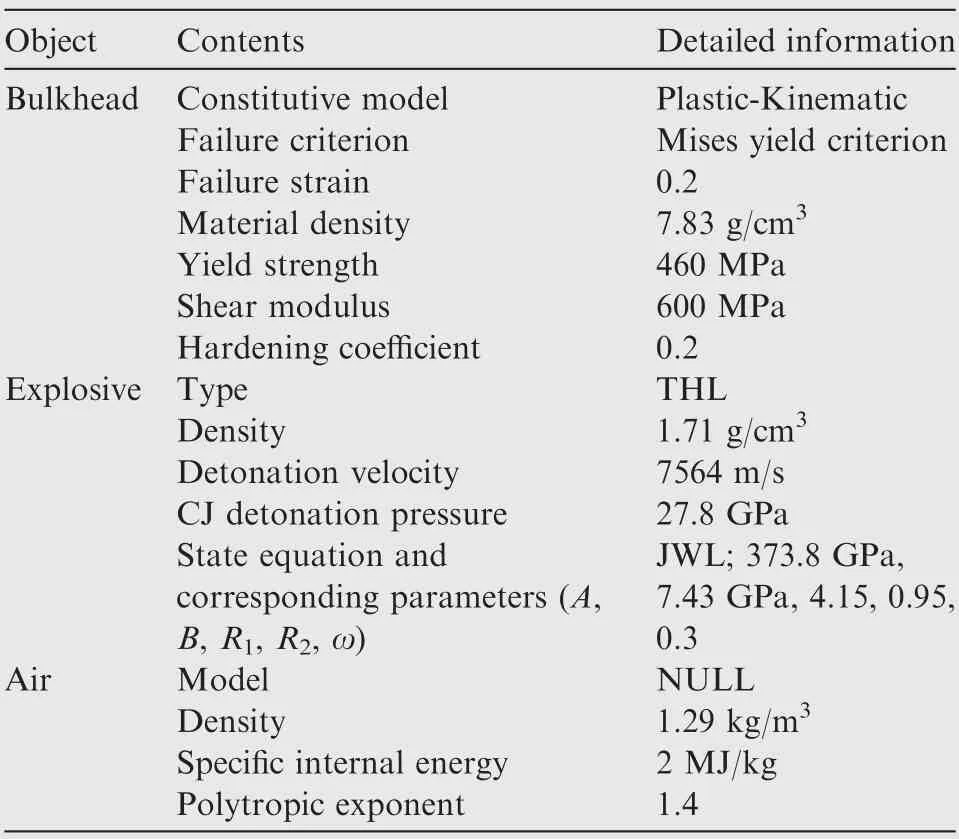
Table 1 Detailed information of simulation object.
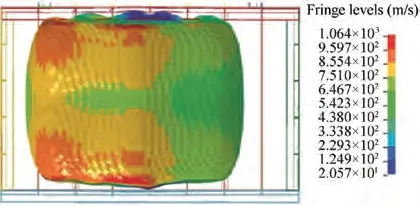
Fig. 3 Cloud diagram of pressure field of the detonation product.
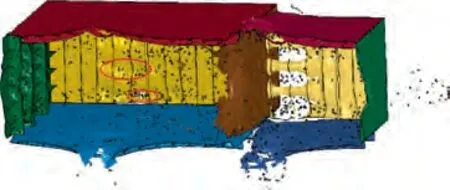
Fig. 4 Fragments on damage effect of cabin.
4. Solution procedure of first-level variables
After obtaining the required data of criteria, it is necessary to first deal with the problem of fuzziness and uncertainty of data, and transform all types of data into unified structure.On this basis, information fusion is carried out on data with unified structure.The belief structure provides a powerful tool to express the fuzziness and uncertainty of criteria, and ER algorithm is facilitated for information fusion. Therefore, the Section 4.1 and Section 4.2 respectively carry out information transformation and information fusion.
4.1. Transformation of criteria information based on belief structure model
In the actual assessment process,it is usually necessary to process both quantitative and qualitative information, including direct measurement values, expert judgment values, and simulation calculation values. According to the actual damage results of anti-ship missiles, all criteria that need to be fused are divided into four assessment degrees: ‘‘poor”, ‘‘average”,‘‘good”, and ‘‘excellent”, which are represented by ‘‘P”, ‘‘A”,‘‘G” and ‘‘E” respectively. In order to facilitate quantitative assessment, the assessment results are quantified from 1 to 100, and the coverage of each assessment degree is shown in Fig. 5.


Fig. 5 Information expression of four assessment degrees.
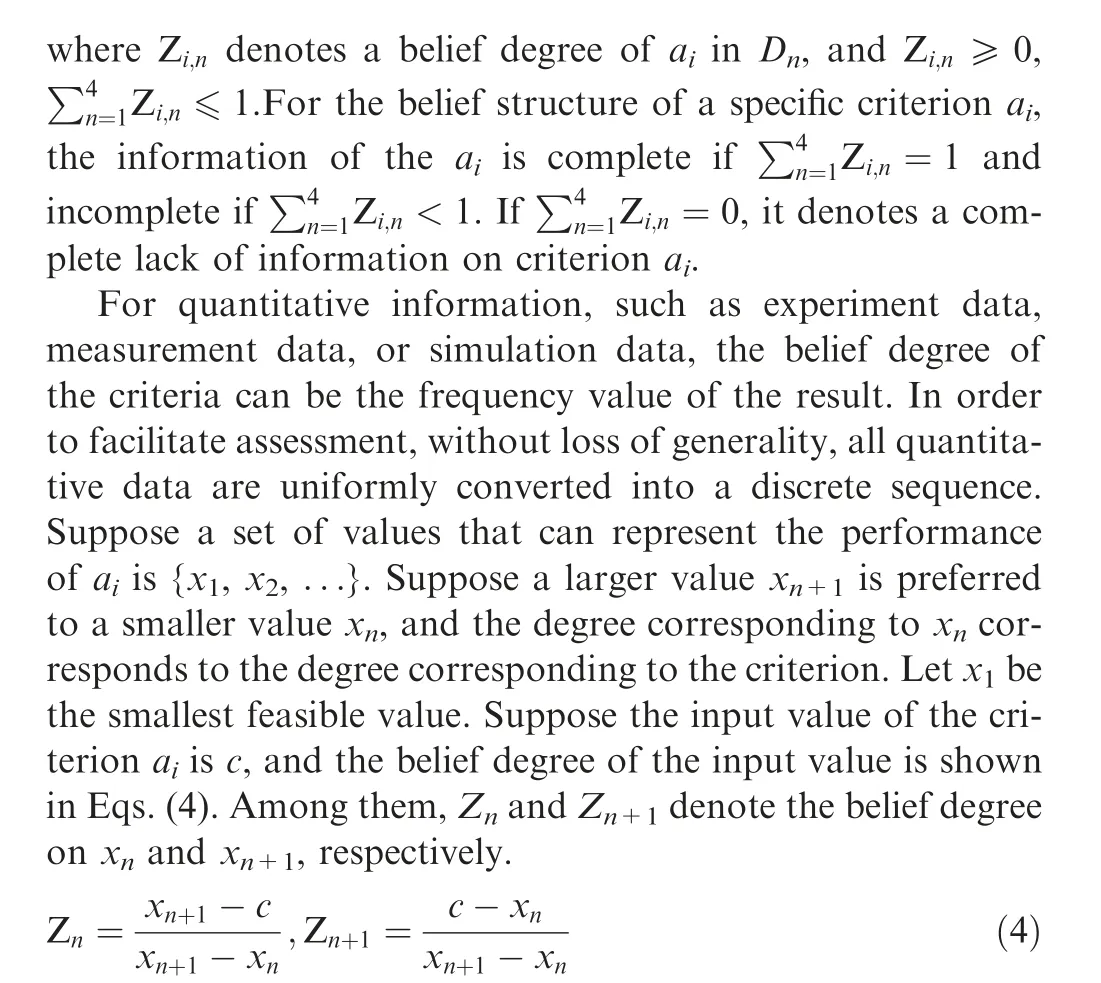
For the qualitative information, combined with the actual situation of assessment process, the expert scoring method is used to score the performance of criteria. In this section,approach with 1-5 points and a scoring step of 1 is used.
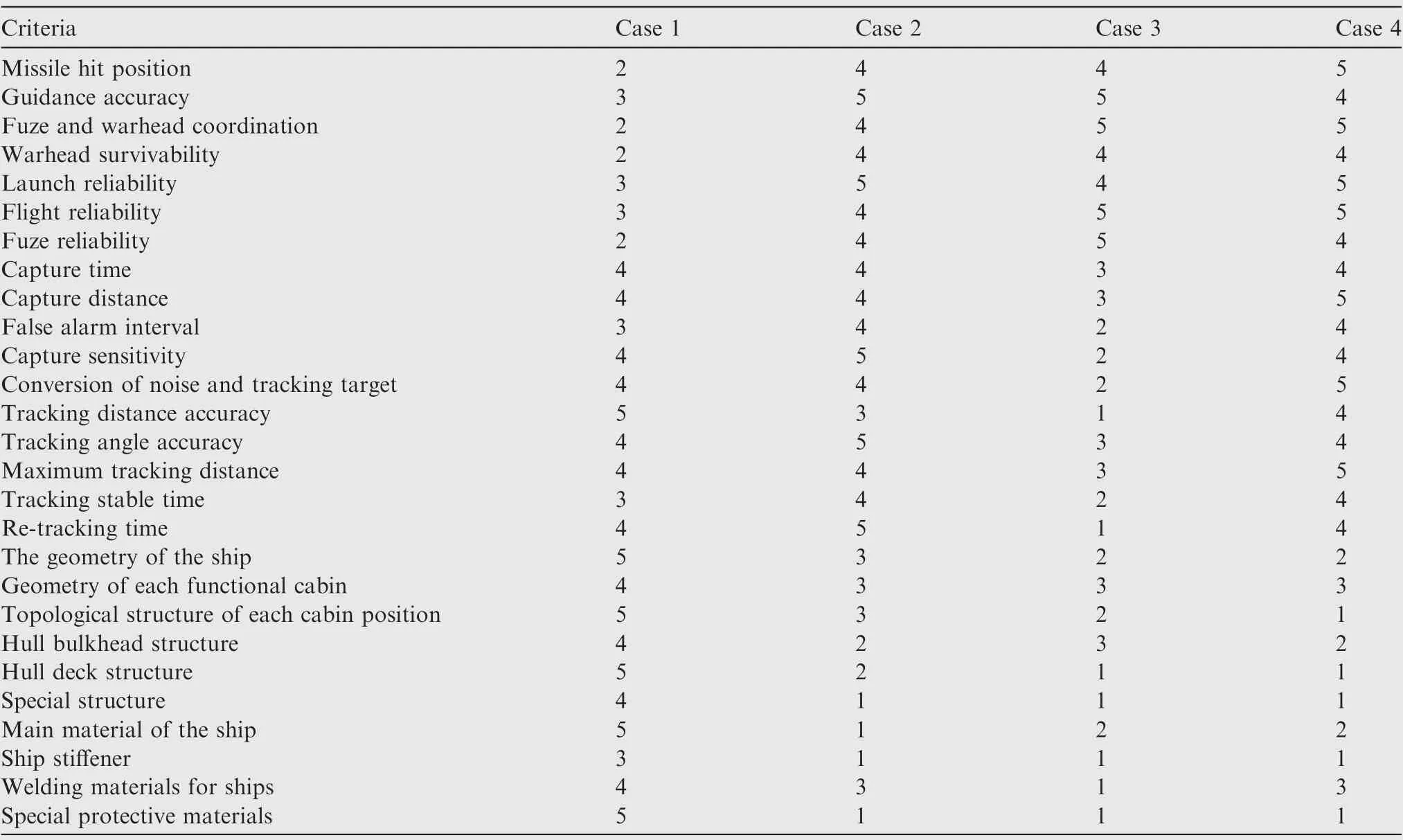
Table 2 Collection of qualitative data.
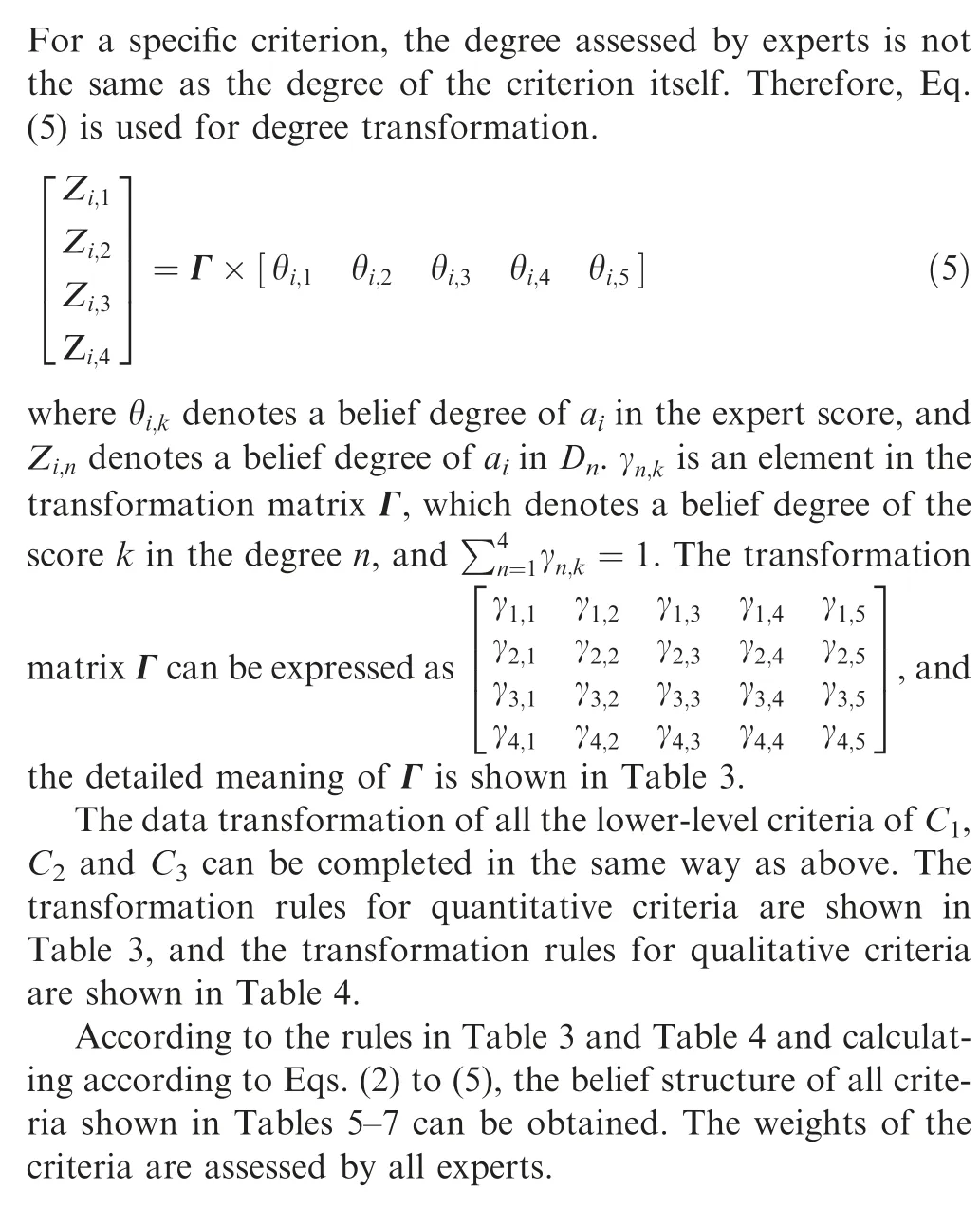
4.2. Aggregation of criteria based on ER approach
Through the above information transformation,all qualitative and quantitative information are denoted in the same belief structure. For an assessment system with hierarchical structure, it is often aggregated from the bottom-level criteria to the top-level criteria. Damage effect assessment has typical hierarchical structure assessment criteria system.ER algorithmcontains the kernel content of ER rule and has strong information fusion capability for hierarchical structure.Therefore,ER algorithm are considered to be used in this section to aggregate the belief structures of all criteria into three first-level variables. The five lower-level criteria of bare used as examples.First,by using the following equations to combine the relative weights and belief degrees of the criteria,the belief degrees are transformed into the following basic probability masses.
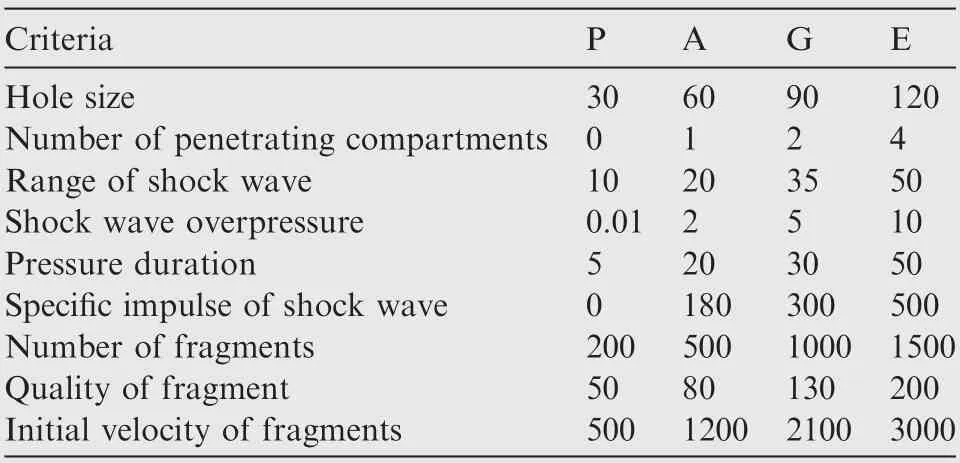
Table 3 Rules of quantitative criteria.

Table 4 Rules of qualitative criteria.
As shown in Eq. (6), the basic probability mass of each belief degree should be calculated.mdenotes the basic probability mass being assessed to assessment degree Don the criterion b.
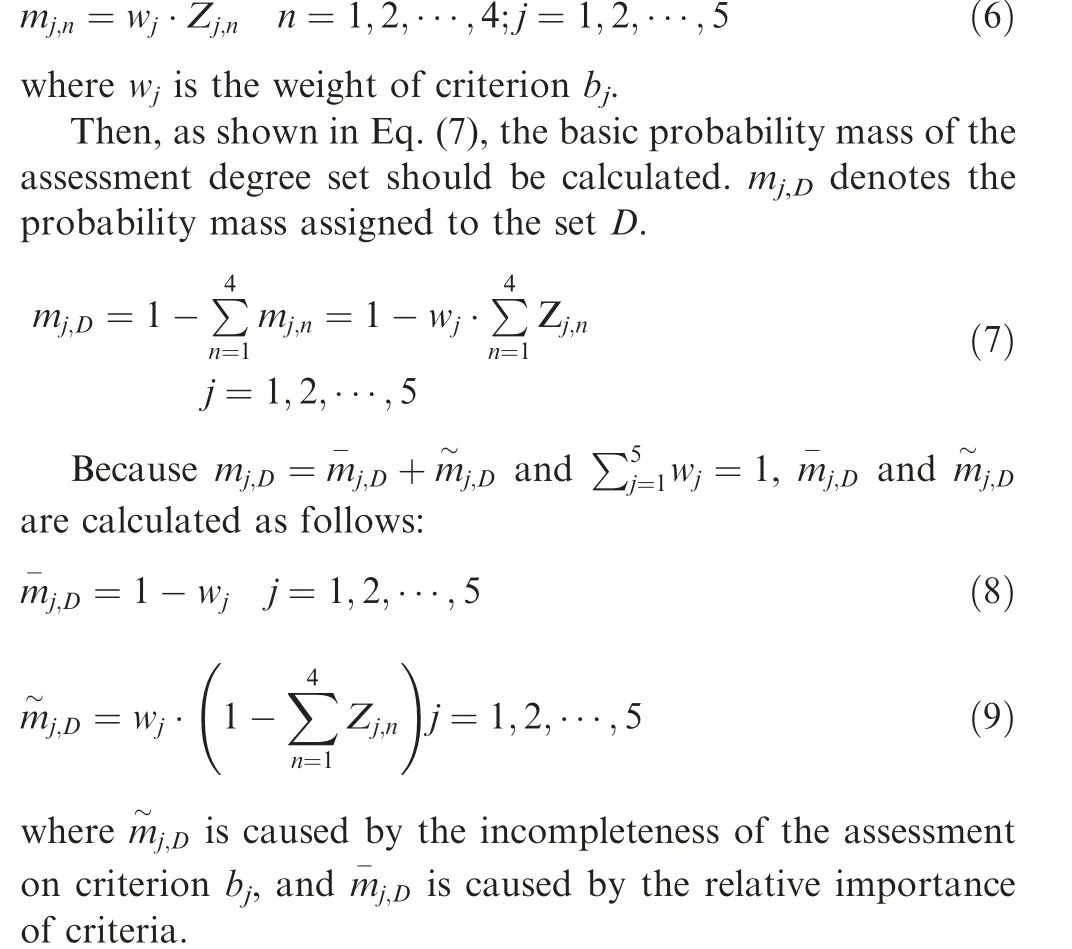
After transforming the lower-level criteria of bfrom the belief structure to the basic probability mass, the following analytic ER algorithm is used to aggregate the basic probability masses, where N is the number of assessment degrees.
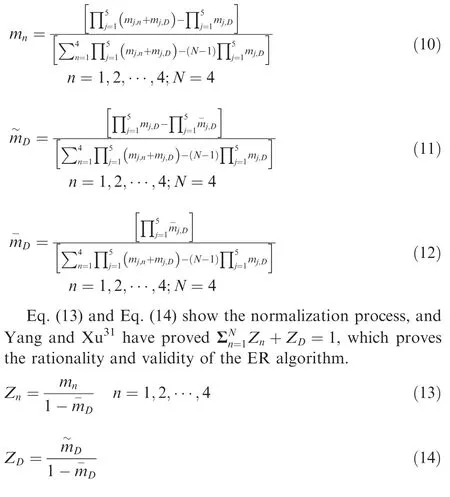

Table 5 Belief structure of lower-level criteria of warhead damage capability.
where Zand Zrepresent the belief degrees of the aggregated assessment,which respectively correspond to degree Dand set D.
In order to show how to fuse the information of lower level criteria to an upper level criterion,information fusion of criteria of bin Case 4 are taken as an example. From Table 6, it can be obtained that
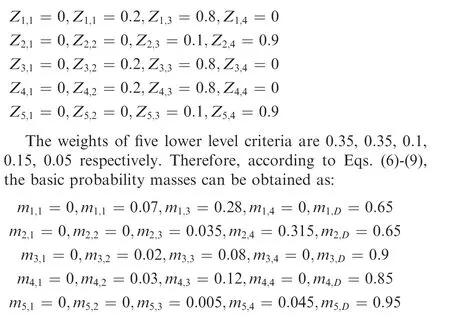
Based on the calculation above,according to Eqs.(10)-(14),the belief structure of bcan be obtained as:

5. Damage effect assessment based on ANFIS
5.1. Construction of an ANFIS
The constructed ANFIS is shown in Fig.6.The input variables represent three first-level variables respectively,and the output E represents the damage effect.In the node,∑represents summation, and ∏means to multiply, and f represents the membership function.
Before inputting,the first-level variables from Table 7 need to be quantificationally transformed first. According to the coverage of each assessment degree in Fig. 5, the coverage of the degree ‘‘average” is the largest, and the coverage of the degree‘‘excellent”is the smallest.Therefore,it is not appropriate to use a completely linear division method to quantitatively assess the four degree from 1 to 100.In order to quantify each degree more scientifically, on the basis of analyzing experts’opinions, ‘‘P”, ‘‘A”, ‘‘G” and ‘‘E” are set to 20, 60, 80 and100 respectively. Therefore, the assessment results in Table 7 are transformed into normalized form according to Eq. (15).

Table 6 Belief structure of lower-level criteria of guidance anti-jamming performance.
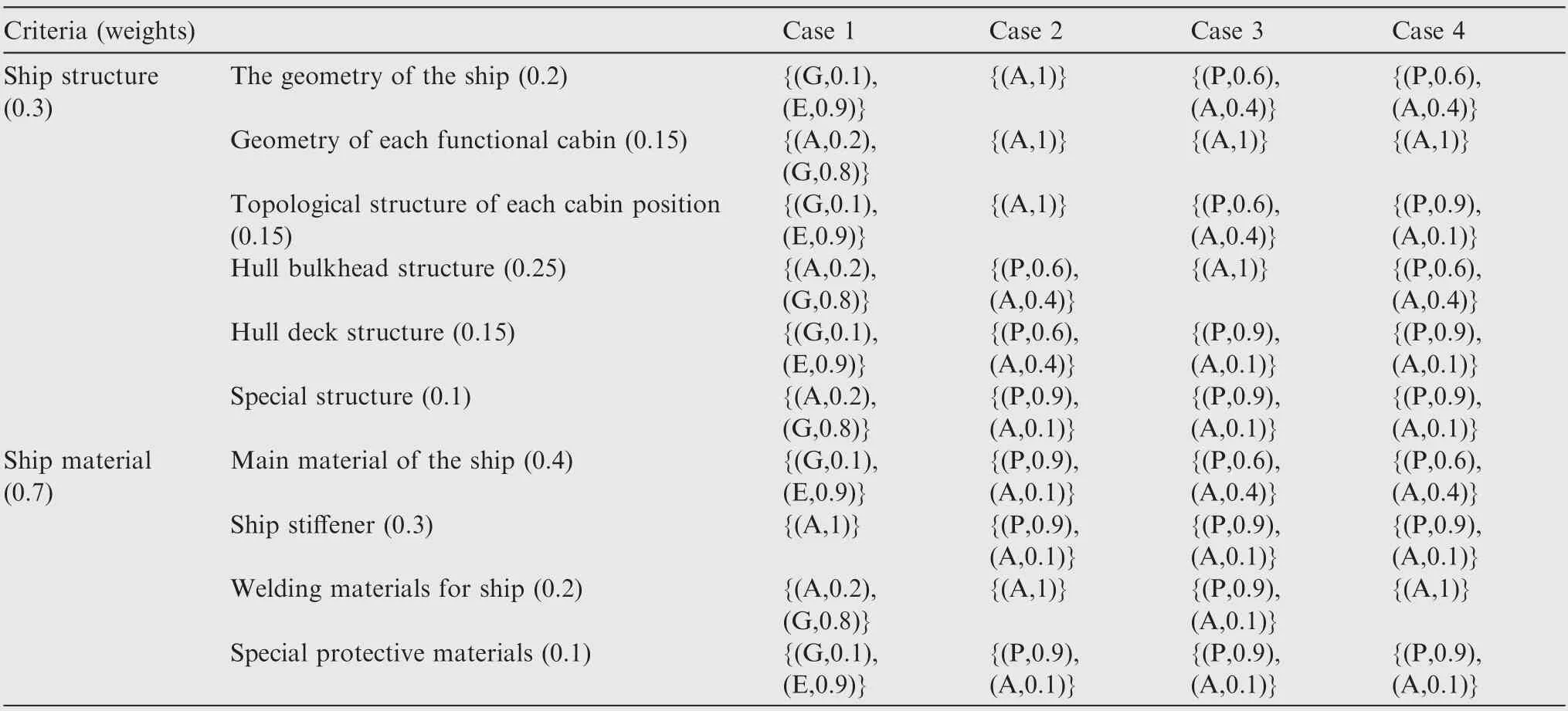
Table 7 Belief structure of lower-level criteria of damage resistance of ship structure.

For three input variables C(i=1-3)and one output variable E,two fuzzy subsets Aand A(k=1-3)are defined on the universe of each input variable, and Erepresents the output of the k-th rule. The fuzzy inference system adopts the Takagi-Sugeno fuzzy logic system, which uses reasoning form as:

In the actual damage process analysis, three damage rules can be obtained. The ANFIS constructed in this paper uses the back-propagation algorithm. The functions of the mod-ules, layers and nodes in Fig. 6 are described as follows. The meaning of parameter j is redefined in this section. If there is no explanation, no calculation is performed on the nodes in the module, and the connection weight between layers is 1.

Table 8 Assessment results of three first-level variables.
(1)Layer α:There are 6 nodes in this layer,which represent the first-level variables C, C, C.
(2)Module A:Constructed of 1 to 5 layers,it completes the function of fuzzy inference.
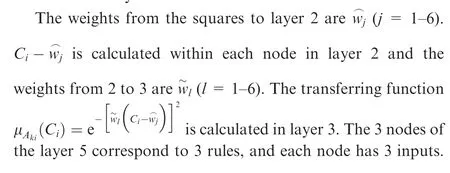
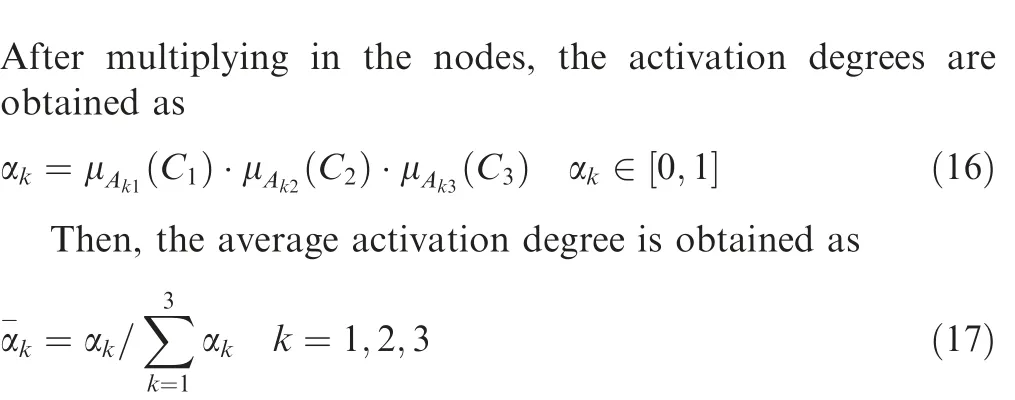

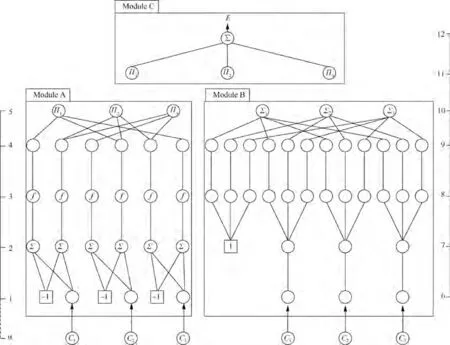
Fig. 6 ANFIS structure of damage effect assessment.
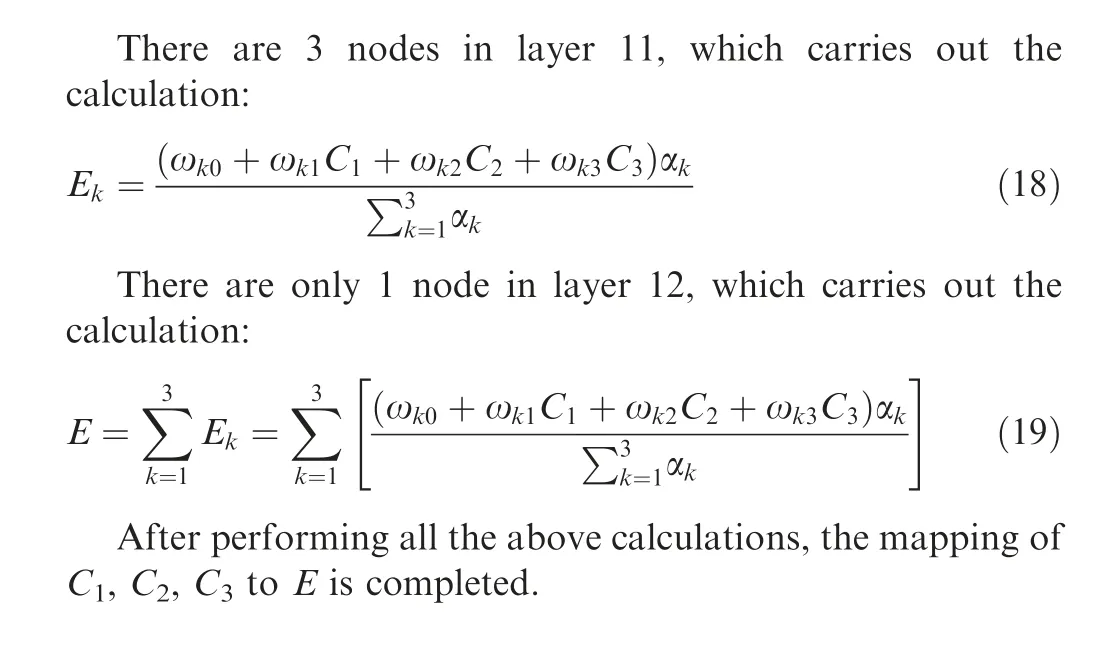
5.2. Calculation of damage effect
The input of the ANFIS is the three first-level variables of damage effect,and the output is the damage effect.After training the ANFIS with the BP algorithm, three fuzzy rules and the contribution of the first-level variables under different rules to the damage effect can be obtained as shown in Table 9,where S represents the sum of the absolute values of the parameters used to solve the contribution of first variables.The damage effect corresponding to the first-level variables is shown in Table 10.
5.3. Analysis of damage effect
It can be seen from Table 10 that the damage effect of anti-ship missiles is relatively high in Case 2 and Case 4,relatively low in Case 3,and lowest in Case 1.By analyzing the data in Table 9 and Table 10, it can be seen that in all the rules, ωis a negative value. This shows that in the process of assessing the damage effect, the contribution of damage resistance of shipstructure is all negative. The increasing trend of damage resistance of ship structure and damage effect is opposite.The coefficients ω, ω, and ωrepresent the contribution degree of C,C,and Cto E respectively.The ωcorresponding to the contribution degree of Care all negative values,while the ωand ωcorresponding to Cand Care all positive values,which means that Cmakes a negative contribution to E during the damage process while Cand Cmake positive contributions. This is very consistent with objective physical facts.Analyzing and comparing Case 2 and Case 3,the damage resistance of ship structure in Case 3 is lower than that in Case 2,and the warhead damage capability in Case 3 is higher than that in Case 2,but the damage effect assessment value in Case 3 is much lower than that in Case 2.Case 3 corresponds to rule 2.By analyzing the parameter contribution values corresponding to the first-level variables in rule 2 and the values of Cand Cin Case 3,it can be seen that although the value of the warhead damage capability is higher, the main factor restricting the increase in damage effect is the guidance anti-jamming performance of anti-ship missiles. Therefore, the main contribution to the damage effect in this case is the guidance antijamming performance. In Case 3, the assessment value of the guidance anti-jamming performance is relatively low.Although the damage resistance of ship structure is very low,the damage effect is still not high. Case 2 and Case 4 correspond to rule 1. When the assessment values of Cand Care both relatively high,the main factor restricting the damage effect is the warhead damage capability. In rule 1, the contribution of ωis much higher than that of ω, which shows that under the condition of good guidance anti-jamming performance,the increasing trend of the warhead damage capability and damage effect is the same.Because the damage effect is the result of the interaction between the warhead damage capability and the damage resistance of ship structure,by analyzing Case 1 and rule 3, we can know that when the damage resistance of ship structure is much higher than the warhead damage capability, because the negative contribution of the damage resistance of ship structure to the damage effect is too large, the resulting damage effect is mainly the contribution of the guidance anti-jamming performance. Combining the actual damage process, although the guidance antijamming performance of the anti-ship missile is excellent and the anti-ship missile can accurately hit the target, because the warhead damage capability is not enough to cause high damage to the ship, the total damage effect is relatively low.
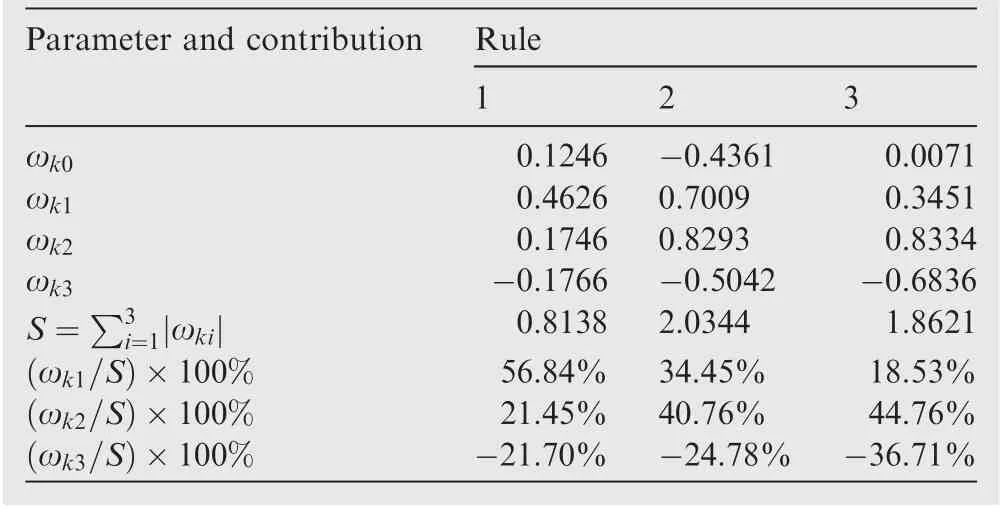
Table 9 Parameters of damage effect assessment and contribution of first-level variables.
Based on the above analysis, it can be concluded that the damage effect of anti-ship missiles on the ship structure is the result of the interaction between the warhead damage capability and damage resistance of ship structure under the influence of guidance anti-jamming performance. Therefore,guidance anti-jamming performance should be guaranteed first to ensure that the anti-ship missile can accurately hit the target.On this basis,it is necessary to improve the warhead damage capability as much as possible, and increase its contribution in the damage effect assessment, which will help improve the total damage effect.

Table 10 Assessment value of damage effect and value of the first-level variable.
6. Assessment results analysis
6.1. Sensitivity analysis
From Fig.1,it can be seen that there are 45 lower-level criteria of C, Cand C, and the weights of many criteria have little difference. If sensitivity analysis is performed directly on the weights of all criteria,it will not only lead to an extremely large amount of calculation, but also does not make much sense.Therefore, it is necessary to carry out a logical analysis of the criteria in the hierarchical structure of the assessment criteria system to find out the criteria that may have a greater impact on the assessment results.
It can be seen from Tables 5 to 7 that in the same case,the assessment values of the lower-level criteria of the same criterion differ very little. Therefore, if the weights of criteria at the same level differ greatly, it means that the relative importance of these criteria also differ greatly. Sensitivity analysis of these criteria may have a great impact on the assessment results, so it is very necessary to conduct sensitivity analysis.Especially when the weight is large, the weight of this type of criteria change even more when the same proportion is changed. The sensitivity of the weights of this type of criteria will be very important. In accordance with the above principles and the actual situation of striking ship, seven criteria of a,a, a, a, a, cand care selected.
In the weight sensitivity analysis, single factor control method is used. That is, when the weight of a criterion changes,the sum of the weights of the same level criteria is still 1,and the other criteria do not change.The weights of criteria a,a,and cchanged in the range of-20%to 20%.The changed value of the weight of each criterion is shown in Table 11,and the change step of weight is 10%.
The first and second sensitivity analysis of the weights of criteria affect the first-level variable Crespectively, and the third sensitivity analysis of the weights of criteria affects the first-level variable C.In order to make the changes in the final assessment results more obvious, the first and second sensitivity analysis use the criteria values in Case 2,and the third sensitivity analysis uses the criteria values in Case 1.The results of three sensitivity analyses are shown in Fig. 7.
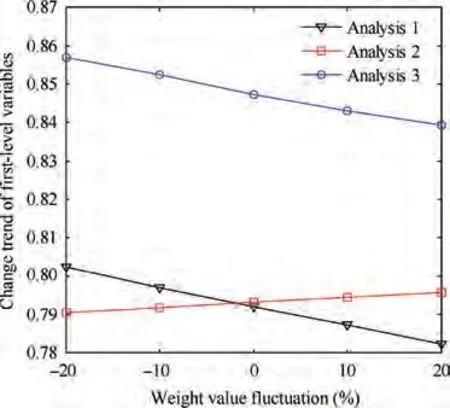
Fig. 7 Change trend of first-level variables with fluctuation of criteria weights.
It can be seen from Fig. 7 that as the weight of the lowerlevel criteria change, the value of the first-level variables will change accordingly. As is shown in Fig. 7, in the range of-20%to 20%,the value of the first-level variable is monotonically decreasing in first analysis and third analysis, but the value of the first-level variable is monotonically increasing in second analysis.However,when the weights of criteria change from-20%to 20%,the amount of change in the value of the first-level variable is very small in all analysis.In first analysis,when the weight change rate of ais from -20% to 20%, the change rate of Cis only 1.88%.In second and third analyses,with the fluctuation of weights, the change rate of Cand Care only 0.65% and 2.06% respectively. That is, the rate of change of the first-level variables are very small and will not have a huge impact on the assessment results. In second analysis, the change in Ccaused by a, a, and ais smaller because a, a, and aare at the lower level of the hierarchical structure of the assessment criteria system.Therefore,it can be judged that the assessment model has good stability, and fluctuations within a certain range will not affect the final assessment results.
6.2. Comparative analysis
In order to verify the accuracy of the above results and replace the simulation results with test results for the assessment, this paper has carried out multiple actual explosion tests.The contents of each test are shown in Table 12.
Fig. 8 shows the left and right stacked cabins. The shock wave overpressure test in the cabin obtains data through the wall pressure sensors, and the Digital Pressure Recorder(DPR) stores the data. Fig. 9 shows the test results of shockwave overpressure at various test points (1-1,1-2,1-3,1-4)inside a cabin. As shown in Fig. 10, the test status is basically the same as that in Case 4.It can be seen that the left and right stacked cabins have been completely damaged.In this case,the damage effect of warhead is very high.

Table 11 Changed criteria weight values.
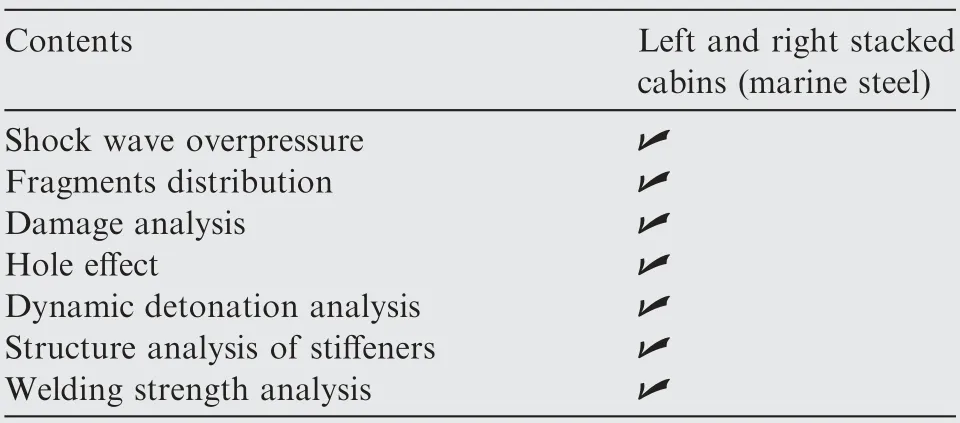
Table 12 Test and numerical simulation content.
The actual damage results of the test of the cabin are assessed by seven experts in this paper, and the comparison between the actual damage assessment result and the assessment result of this process is shown in Fig. 11. The state of the cabin and warhead under the test conditions is basically the same as Case 1- Case 4.
As is seen from Table 10, the damage effect assessment results of Case 1- Case 4 are 0.2686, 0.7324, 0.4293 and 0.7541 respectively. After obtained the experts’ assessment results of the actual damage results, the weighted summation results of experts’ assessment results are conducted and final assessment results of the actual damage results of Case 1-Case 4 are 0.4437, 0.9133, 0.4896 and 0.9358 respectively. Actually,because the consistency of the test status,the variation trend of the damage effect assessment results of the process in this paper are basically consistent with the actual damage assessment results. However, the absolute errors of two groups of results can be obtained as 0.1753, 0.1809, 0.0603 and 0.1817 respectively. It can be known that the damage effect assessment results of the process in this paper are obviously smaller than actual damage assessment results except that of Case 3.
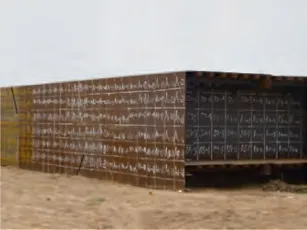
Fig. 8 Left and right stacked cabins.
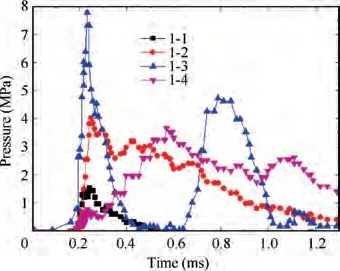
Fig. 9 Test results of shock wave overpressure at various test points inside a cabin.
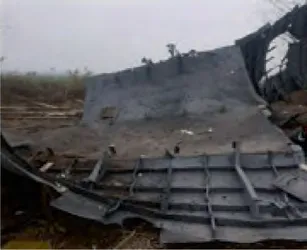
Fig. 10 Damage result of the upper and lower stack after test.
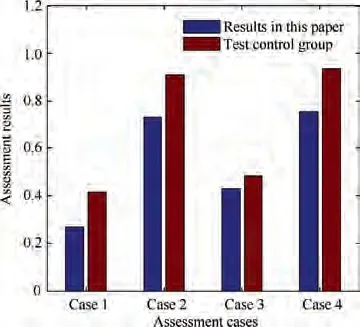
Fig.11 Damage degree of the left and right stacked cabins after test.
There are two main reasons for the analysis.The first is that the basic data obtained is generally conservative. Most of the basic data used in this paper comes from expert assessment,so it can reflect that experts generally prefer to give more conservative data during the assessment process. When conducting actual tests, because the results of the tests have become objective facts, even if the experts are conservative, they will give an assessment value consistent with the test results. The second is that the model in this paper can greatly retain the original information. The conservative attitude of experts can be transferred from basic data to assessment results through models.
Through comparative analysis,it can be concluded that the assessment model in this paper is effective.But the accuracy of the assessment results also depends on more accurate basic data.Therefore,in the process of collecting data,this problem should be paid attention to.
7. Conclusions and future works
By studying the damage effect assessment process proposed in this paper, the following three conclusions are drawn:
(1) The assessment process proposed in this paper can basically simulate the relationship between criteria in the assessment process. This is conducive to accurately assess the damage effect of anti-ship missiles on the basis of obtaining the lower-level criteria data. In the case of flexibly adjusting the damage source and damage object according to the specific situation, the model can also provide a reference for assessing the damage effect of the missile against other targets.
(2) Through the analysis of the damage effect assessment results and rules, it can be concluded that the premise of improving the damage effect is to improve the guidance anti-jamming performance of anti-ship missile to increase the hitting effect. On this basis, because the damage effect is the result of the interaction between the damage resource and the damaged object, the warhead damage capability of the anti-ship missile should be improved as much as possible. The charge in the ammunition should be optimized from the root cause to maximize the damage effect of several damage ways.
(3) The ANFIS established in this paper can obtain the contribution value of each variable in the process of aggregating three first-level variables. By analyzing the data,the similarities and differences of the influencing factors of various damage processes can be obtained, which reflects the process of interaction between the damage resource and the damage object under the influence of guidance factors. If the contribution of lower-level factors to upper-level factors needs to be further calculated during the damage effect assessment process, ANFIS can be further constructed on the basis of this paper and rules can be extracted.
This paper does preliminary work on the methodology of damage effect assessment. If the more complex issues of fatal damage on ship,multiple damages,and interdependence of criteria are considered, further research is needed on the basis of this paper.
The authors declare that they have no known competing financial interests or personal relationships that could have appeared to influence the work reported in this paper.
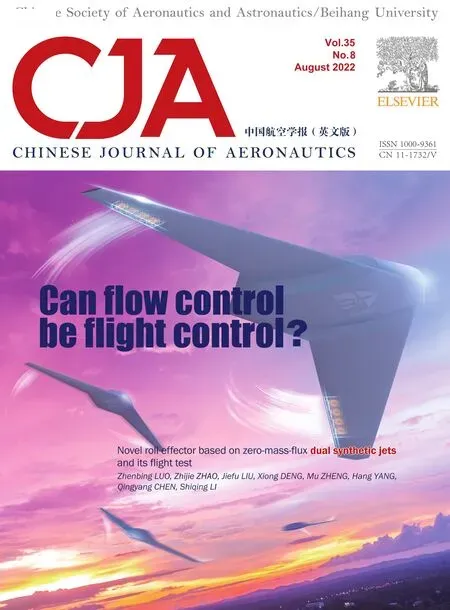 Chinese Journal of Aeronautics2022年8期
Chinese Journal of Aeronautics2022年8期
- Chinese Journal of Aeronautics的其它文章
- Active, compact, wideband, receiving filtenna with power adaptation for space-limited wireless platforms
- Deployment of SMP Miura-ori sheet and its application: Aerodynamic drag and RCS reduction
- Beam tracking method based on reconfigurable intelligent surface for obstructed communication
- An alternative method to reduce process-induced deformation of CFRP by introducing prestresses
- Novel orbit-attitude combination mode for solar power satellites to reduce mass and fuel
- Experimental study on transfer functions of an active rotor under different flight conditions
